
Welcome to memphissnakes.com! I am David, a snake enthusiast living in Memphis, TN. Many people don't know that Memphis is in fact full of snakes! You just need to know where to find them - they can often be shy and elusive. Some Tennessee snake species are more common outside of the city limits, in different parts of Shelby County TN, but many types of snakes are indeed common in the more urban parts of Memphis. This guide is meant to help educate you about the beautiful snakes of Memphis, and to help you identify the most common snakes of Memphis, as well as the venomous snakes of Memphis that you should learn to recognize and avoid. If you want more detail, click here for my complete list of ALL snake species in Memphis. Remember the following:
- Most snakes of Memphis are harmless and don't want to encounter you
- Venomous snakes exist but are uncommon in Memphis, Tennessee
- Snakes eat rats and mice and are a valuable part of the Tennessee ecosystem
- Never kill a snake - if you leave a snake alone, it will leave you alone.
Common Snake Species in Memphis
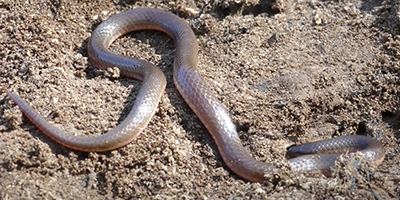 Eastern Wormsnake:
The eastern wormsnake (Carphophis amoenus) is a small, non-venomous snake you may encounter in Tennessee. On average, the adult eastern wormsnake won’t grow past 11 inches, measuring just under 30 cm in length. It has a slender body that lacks any distinctive pattern and is usually just one solid color, most often a dark shade of brown. It can be found both in wetlands and woodlands, but is a rare sight because its burrowing activities keep it largely underground. As such, it mainly eats worms and larvae it can easily find underground, but will occasionally also go for other soft-bodied prey.
Eastern Wormsnake:
The eastern wormsnake (Carphophis amoenus) is a small, non-venomous snake you may encounter in Tennessee. On average, the adult eastern wormsnake won’t grow past 11 inches, measuring just under 30 cm in length. It has a slender body that lacks any distinctive pattern and is usually just one solid color, most often a dark shade of brown. It can be found both in wetlands and woodlands, but is a rare sight because its burrowing activities keep it largely underground. As such, it mainly eats worms and larvae it can easily find underground, but will occasionally also go for other soft-bodied prey.
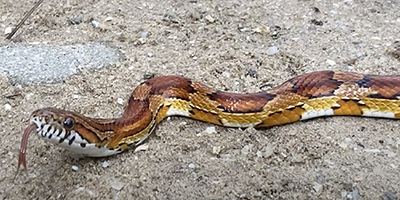 Red Cornsnake:
The red cornsnake (Pantherophis guttatus), also sometimes referred to as the red rat snake, is a long snake, often reaching up to 6 feet (180 cm). It has a slender body and round pupils, but is often mistaken for the venomous copperhead, and thus subsequently killed. Its body usually has bright, orange, yellow, and red colors, lined with black, while its belly has an unusual black and white pattern. It’s mostly found in woods, but also fields and on farms, where it mainly feeds on small rodents.
Red Cornsnake:
The red cornsnake (Pantherophis guttatus), also sometimes referred to as the red rat snake, is a long snake, often reaching up to 6 feet (180 cm). It has a slender body and round pupils, but is often mistaken for the venomous copperhead, and thus subsequently killed. Its body usually has bright, orange, yellow, and red colors, lined with black, while its belly has an unusual black and white pattern. It’s mostly found in woods, but also fields and on farms, where it mainly feeds on small rodents. 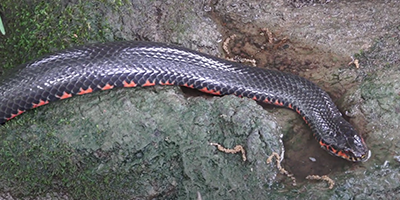 Red-bellied Mudsnake:
The red-bellied mudsnake (Farancia abacura), true to its name, has an unusual red and black pattern on its belly, which makes it fairly easy to spot. It’s quite a large snake, growing up to 54 inches (around 115 cm), and has a heavy body. Its chin is often marked with yellow specks, which further contrast the black and red. It mainly lives near water, in marsh areas.
Red-bellied Mudsnake:
The red-bellied mudsnake (Farancia abacura), true to its name, has an unusual red and black pattern on its belly, which makes it fairly easy to spot. It’s quite a large snake, growing up to 54 inches (around 115 cm), and has a heavy body. Its chin is often marked with yellow specks, which further contrast the black and red. It mainly lives near water, in marsh areas.
Venomous Snake Species in Memphis
 Copperhead:
The copperhead is one of the most widespread types of venomous snakes across the US. It is a pit viper with a fairly stout and long body, growing to 36 inches (or roughly 1 m). They have earthy colors on their bodies, with a lighter shade as the base, and slightly darker variations for the blotches, which are shaped like an hourglass. It prefers rocky or wooded areas that make it difficult to detect and mainly feeds on small mammals. Since the copperhead is not an aggressive snake, it’s not responsible for a lot of fatalities.
Copperhead:
The copperhead is one of the most widespread types of venomous snakes across the US. It is a pit viper with a fairly stout and long body, growing to 36 inches (or roughly 1 m). They have earthy colors on their bodies, with a lighter shade as the base, and slightly darker variations for the blotches, which are shaped like an hourglass. It prefers rocky or wooded areas that make it difficult to detect and mainly feeds on small mammals. Since the copperhead is not an aggressive snake, it’s not responsible for a lot of fatalities.
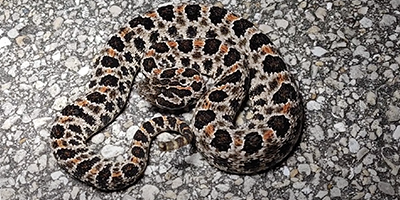 Pygmy Rattlesnake:
The pygmy rattlesnake (Sistrurus miliarius) is, as its name suggests, a very small type of pit viper. A mature adult only measures around 24 inches (so roughly, 60 cm) in length, though it has a fairly stout body. The pygmy rattler is quite colorful, making it easy to spot in the grass. Its body is usually a pinkish tan or light brown, with dark dorsal blotches, while its belly is a dusky pink. The pygmy rattler prefers living in close proximity to water, but may also be found in woods and rock beds. It mainly feeds on lizards, frogs, and small rodents. Because of its small size, its cytotoxic venom usually isn’t enough to truly harm a human adult.
Pygmy Rattlesnake:
The pygmy rattlesnake (Sistrurus miliarius) is, as its name suggests, a very small type of pit viper. A mature adult only measures around 24 inches (so roughly, 60 cm) in length, though it has a fairly stout body. The pygmy rattler is quite colorful, making it easy to spot in the grass. Its body is usually a pinkish tan or light brown, with dark dorsal blotches, while its belly is a dusky pink. The pygmy rattler prefers living in close proximity to water, but may also be found in woods and rock beds. It mainly feeds on lizards, frogs, and small rodents. Because of its small size, its cytotoxic venom usually isn’t enough to truly harm a human adult.
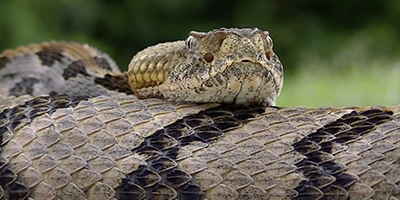 Timber Rattlesnake:
The timber rattler (Crotalus horridus) is the largest and most dangerous of the venomous snakes in Tennessee. As a fully matured adult, it grows up to 60 inches (152 cm), and has quite a fat body, weighing up to 1,000 grams sometimes. It has a light base color, often a dark tan or yellowish-brown, with a pattern of dark brown or black crossbands. The rattler usually prefers wooded areas and tends to live in cooler places (an exception being pregnant females). While the rattler is pretty dangerous (because of its large fangs and an impressive amount of venom), it is not responsible for a lot of fatalities, thanks to its mild, non-aggressive nature.
Timber Rattlesnake:
The timber rattler (Crotalus horridus) is the largest and most dangerous of the venomous snakes in Tennessee. As a fully matured adult, it grows up to 60 inches (152 cm), and has quite a fat body, weighing up to 1,000 grams sometimes. It has a light base color, often a dark tan or yellowish-brown, with a pattern of dark brown or black crossbands. The rattler usually prefers wooded areas and tends to live in cooler places (an exception being pregnant females). While the rattler is pretty dangerous (because of its large fangs and an impressive amount of venom), it is not responsible for a lot of fatalities, thanks to its mild, non-aggressive nature.
If you're unsure, you can email me a photo of the snake at info@memphissnakes.com and I will email you back with the snake's species. If you found a snake skin, read my Found a Skin? page, and you can email me a photo of the skin, and I'll identify the snake for you. If you need professional Memphis snake removal help, click my Get Help page, or see the below website sponsor I found, who provides that service.
Remember, the term is not poisonous snakes of Memphis, it's venomous snakes of Memphis. Poison is generally something you eat, and venom is injected into you. That said, dangerous snakes are very rare in Memphis. The few venomous snakes of Shelby County are rarely seen. But they are commonly misidentified, so learn about all the snake species of Memphis in order to correctly identify them. These snakes are usually also found in the surrounding towns of Memphis, Collierville, Germantown, Bartlett, Millington, Arlington, Lakeland and the surrounding areas.
Read our article about:
Snakes and Their Bones
memphissnakes.com domain and hosting costs made possible by the generous support of this sponsor:
